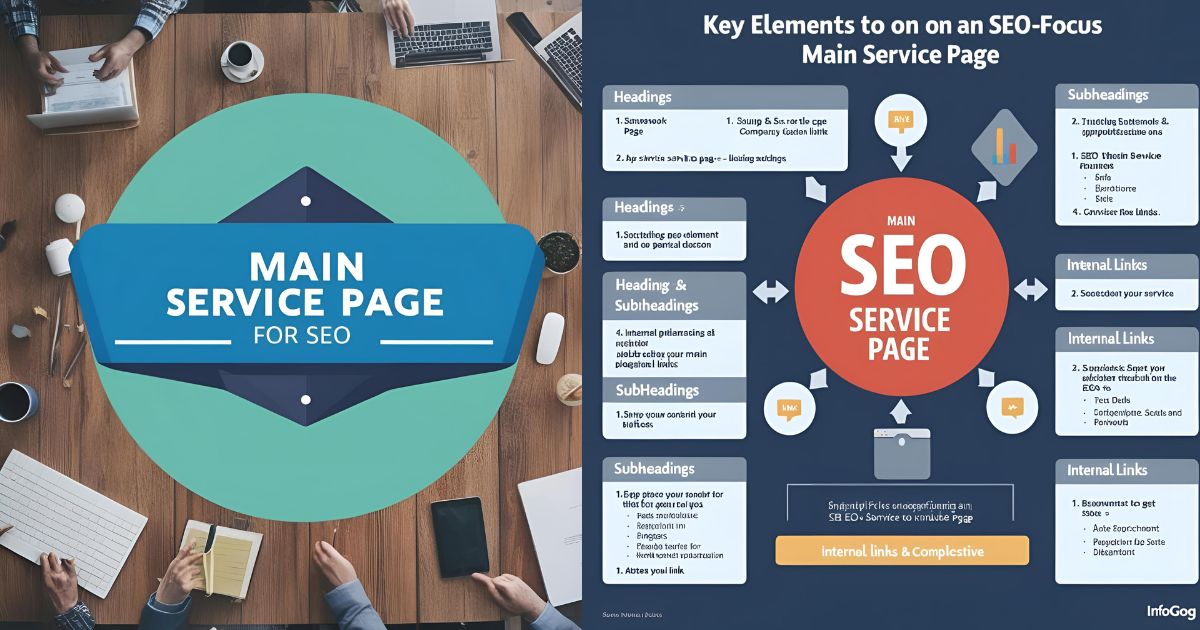Absolutely. Below is a clear, actionable breakdown for H2: 3–5, structured in Brian Dean’s concise, benefit-driven content style. It uses active voice, short paragraphs, and highlights user-focused outcomes while naturally integrating semantically related terms.
Clear Service Overview & Benefit-Focused Copy
Your service page must communicate value within seconds. If users can’t immediately understand what you offer and why it matters, they’ll bounce.
Here’s how to do it right:
-
Start with a strong headline that clearly names the service. Example: “Local SEO Services for Small Businesses.”
-
Add a 1–2 sentence intro explaining the problem your service solves.
-
Use bullet points to list key features. Keep them short, clear, and benefit-driven:
-
Rank higher in local search results
-
Attract high-intent traffic
-
Convert visitors into paying clients
-
Link each service (or sub-service) to a dedicated internal page for deeper SEO and UX value.
-
Add a short section titled: “Why This Service Matters”
Explain the ROI. Tie your service to results like increased visibility, leads, or sales.
🔑 Pro Tip: Include long-tail variations like “optimize service page content” or “SEO for service-based businesses” in section copy.
Visual & Multimedia Elements
People process visuals 60,000x faster than text. The right image can increase trust, reduce bounce rate, and reinforce key messages.
Include these must-have visual assets:
-
Hero image above the fold — show the transformation or core benefit.
-
Before-and-after screenshots for results-driven services (e.g., improved rankings, traffic growth).
-
Short explainer videos (30–90 seconds) to humanize your brand and clarify complex services.
-
Use infographics or visual checklists to break down your SEO process or deliverables.
Optimize for SEO:
-
Use descriptive filenames (e.g., seo-service-page-structure.png)
-
Include keyword-rich alt text naturally:
📷 Tip: Use image compression tools like TinyPNG or WebP to ensure fast loading without sacrificing quality.
Trust & Social Proof
Trust is the tipping point between a visitor and a conversion. Without it, even perfectly written service pages fall flat.
Testimonials & Case Studies
Let your happy clients do the talking.
-
Include 2–4 client testimonials, each with:
-
Name, photo (if possible), company
-
Specific result they achieved (e.g., “30% increase in leads in 90 days”)
-
Case studies or success snapshots show proof, not promises. Embed:
-
Project summary
-
Challenges + solutions
-
Results with numbers
💡 Add Review schema markup to help your testimonials show up in Google’s rich snippets.
Trust Badges & Credentials
Reinforce credibility with recognizable signals of authority.
-
Display partner logos (Google Partner, SEMrush Certified, etc.)
-
Add industry certifications or awards — even local recognitions work.
-
Include a security badge (SSL, privacy protection) if there’s any form submission.
🏆 These visual cues reduce friction and build confidence—especially for first-time visitors.
Strategic Calls-to-Action (CTAs)
Your content may be strong, but if users don’t know what to do next, you’re losing conversions.
Effective CTAs guide visitors toward action.
Here’s how to do it right:
-
Place a primary CTA above the fold
Make it visible the moment someone lands on the page.
Example:
👉 “Request a Free SEO Audit” or “Get a Free Quote Today”
-
Use action-oriented button text
Ditch “Submit.” Use high-intent phrases:
-
“Schedule My Call”
-
“Start My SEO Plan”
-
“See Pricing Options”
-
Repeat CTAs throughout the page, especially:
-
After testimonials or case studies
-
At the end of the service description
-
In sticky headers or sidebars (mobile-friendly)
-
Create contextual CTAs based on user stage:
📌 Pro Tip: Use CTA colors that contrast the background and draw attention. Make the buttons large enough for mobile users.
Technical SEO & Performance
A service page that loads slowly or breaks on mobile will tank rankings and frustrate users.
Optimizing technical SEO ensures search visibility and user satisfaction.
Mobile & Speed Optimization
Most users browse service pages on their phone. Google knows this—and so should you.
Follow these steps:
-
Use responsive design: Your page should adapt to every screen size.
-
Aim for load times under 3 seconds:
-
Implement mod_PageSpeed or similar tools to automate performance tweaks.
📊 Tools like PageSpeed Insights and GTmetrix help you identify speed bottlenecks.
Cited by: Fable Heart Media, Arrow AI, Search Engine Land
Structured Data Markup
Structured data helps Google understand your content—and rewards you with rich snippets.
Types of schema to include on a main service page:
-
LocalBusiness — for local SEO and map pack visibility
-
Organization — identifies your brand structure
-
FAQPage — boosts visibility in “People Also Ask”
-
Review — displays ratings directly in search results
🧠 Use Google’s Rich Results Test to validate your markup.
Referenced by: Arrow AI, SEOSpace
Clean URLs & Heading Structure
Messy URLs and unstructured headers confuse both users and search engines.
Here’s how to keep your content clean and crawlable:
-
Use short, descriptive URLs
Example:
✅ /seo-services/local
❌ /page.php?id=72843
-
Include primary keywords in the URL
Avoid stop words and unnecessary parameters.
-
Use a clear heading hierarchy:
-
Keep headings concise and include semantically related terms where natural:
Best practices seen on: Fable Heart Media, HubSpot Community, Reddit
Internal Linking & Site Architecture
Internal links are SEO gold—when used strategically.
They distribute authority, improve crawlability, and guide users to deeper content.
How to implement it effectively:
-
Link to sub-service pages from your main page
→ Example: From “SEO Services” to “Local SEO” or “Technical SEO”
-
Add links to relevant blog posts
→ Example: “Learn how to audit your SEO service page structure”
-
Use descriptive, keyword-rich anchor text
→ Instead of “click here,” write: “our local SEO strategy guide”
-
Follow a silo structure:
-
Add breadcrumbs to help users (and bots) understand the page’s position in your site hierarchy
🔗 Internal linking improves UX, lowers bounce rates, and signals topical authority to search engines.
Referenced by: Fable Heart Media
Local SEO Optimization (if applicable)
If you’re targeting a specific city, region, or service area, local SEO isn’t optional — it’s essential.
Google prioritizes local relevance. So should your service page.
Here’s how to optimize for local search:
-
Embed your full NAP (Name, Address, Phone Number)
-
Place it in the footer or a sidebar
-
Ensure it’s consistent across your website and listings (Google Business Profile, directories)
-
Add an interactive Google Map
-
Mention service areas clearly
-
Use phrases like:
-
“Serving small businesses across Denver, CO”
-
“Available in Toronto, Mississauga, and the GTA”
-
Include local keywords in headings and body text:
🧭 Pro Tip: Create localized internal links (e.g., /seo-services/chicago) and mention landmarks or neighborhoods for hyper-local context.
Referenced by: The Media Captain, SEOSpace, Fable Heart Media
FAQ Section
FAQs aren’t filler. They answer real user questions, reduce bounce rates, and increase chances of earning rich snippets.
How to build an SEO-smart FAQ section:
-
Source your questions from the SERP
-
Type your target keyword into Google
-
Note the “People Also Ask” entries
-
Look for recurring phrases like:
-
Answer each question in 2–4 sentences
-
Be concise, clear, and helpful
-
Use formatting like bolding key phrases or lists if necessary
-
Add 4–6 questions max to avoid clutter
-
Wrap your FAQ in schema markup
✅ Bonus: FAQs also help address objections and reduce support requests.
Conclusion
Your service page is more than just a place to list offerings — it’s a conversion tool and SEO asset rolled into one.
We’ve covered the 11 essentials that make a service page rank and perform: from keyword targeting and headline structure to schema markup, internal linking, and trust elements.
Every section you add with purpose — a CTA, testimonial, or FAQ — moves your visitor closer to taking action.
If you’re serious about driving leads and standing out in search, now’s the time to implement what you’ve learned.
Use the free checklist or template to map out your page step by step. No guesswork, just results.
Got questions or want expert eyes on your draft? Drop a comment or reach out for a free consultation. Let’s make your service page work harder — and smarter.


